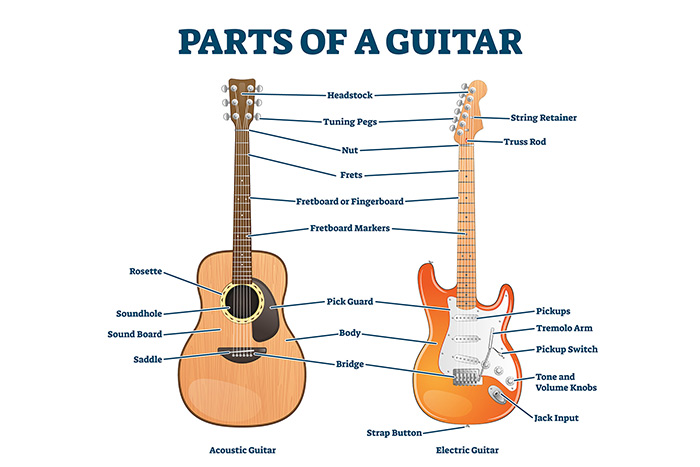Less Is More
When we’re talking about funk guitar or just funk in general, less is more is the mindset that we need to approach it with. Funk is all about the space between the notes, rather than the notes themselves. In fact, what usually makes up a funk song is rather simple. Unlike other musical styles, funk is often centred around one or two chords, usually one chord per section of a song, meaning it is much more rhythmically driven rather than harmonically. When we think of funk we often think of one artist in particular, that artist of course being James Brown. Most of Brown’s music is often centred around a one chord vamp (usually on a dominant 7 chord), to then change to the IV in the bridge or B section of the song.
The guitar will often be playing relatively simple parts in these sections, which are more rhythmically driven and will always be sure to not step on the toes of the other instruments and Mr Brown’s vocals. Let’s take one of his more well known songs as an example of all of the above, “I Got You (I Feel Good)”. This tune has a lot of instrumentation going on: guitar, bass, drums, and a horn section. One thing that is very apparent is that each instrument knows its role and makes room for each other. The drums and bass are more constant and give us that funky groove to lock in to, but the horns and guitar stay clear out of the way of the vocals, and actually play whenever James isn’t singing. The guitar part in the verses of the song is incredibly simple, only giving us a chord stab on beat 2 of every second bar, also keeping out of the way of the horn section, playing before it.
Add Extra Notes To An Existing Chord
So we’ve established that funk in general is very simple, and more rhythmically based, so how can we start incorporating this mindset into our funk guitar playing? One way is to add in extra notes to the existing chord that is in the song, which in funk will usually be the only chord for the entire section in a vamp style. Let’s take James Brown’s song “Get Up I Feel Like Being A Sex Machine” as an example (and don’t worry – there’s plenty more JB to come).
The main verse section of this song is based on a static Eb9 chord (side note – funk loves a dominant 9th chord, so a great place to start would be to sub out all of the regular dominant 7ths out for 9ths). This song is a little more guitar driven, with that main guitar part being a simple Eb9 chord with the top note of the chord alternating between the 5th and then the 6th degree. The 6th is of course not usually in a dominant 9 chord, so this gives us a bit of a different flavour and also gives us more of a top note melody to follow and therefore creating more of a guitar ‘part’, rather than just a chord.
Switch Between Bass Notes And Higher Chordal Playing
Funk guitar also loves playing short staccato bass line type parts as well, sometimes alternating between this more bass like role and playing high jangly parts. Have a listen to “Give It Up Or Turnit Loose” by, you guessed it, James Brown. The guitar is playing a staccato bass creep up to the tonic of the D7 chord, chromatically descending from the b7 to the tonic to a specific rhythm, to then quickly jumping into playing the higher notes of the chord. This approach allows the guitar to sometimes follow the bass whilst also locking in with the higher register instruments such as the horn section in one cool part. Sometimes this may get too messy depending on the roles of the other instruments, but since this particular guitar part really carries this song it’s more of a situation where the other instruments follow the guitar rather than the guitar getting out of the way of everyone else (like we heard in “I Got You (I Feel Good))”.
Relationship Between The Right And Left Hand
Not only does the style of funk guitar rely so heavily on rhythm, its also all about note length. Choosing which notes are short and funky and which ones will sustain or decay for longer will have a massive effect on how the part sits with every other instrument in the band. Shorter notes give us more space in between to breathe and make room for other instruments, and also create a nice contrast to the longer sustained notes which give the music a chance to open up and create excitement.
The way that we control this on the guitar is through the relationship between the right and left hand, and thinking about what roles both of these will play. The right hand (or strumming hand) will control our rhythm and drive the part along, but can also play muted notes in a percussive fashion to simulate the drums and lock in with other instruments. The left hand will be doing a lot of muting, constantly pressing notes to create a clear sound and taking the pressure off of the string to mute the sound and create a staccato note. This will be extremely important to controlling our note length. Both hands are responsible for creating contrast in each note and chord that we play, very purposely making our long notes long and our short notes short.
The Roles Of The Different String Groupings
We can also think about our different string groupings as simulating different instruments in the band, locking in with different members of the band at different times. The lower E and A strings will often lock in the with the kick drum of the drum kit, as they live in the bass register. This will mean that this string grouping will also lock in with the bass player as well for different bass lines. The higher string groupings will replicate the role of the snare, often playing chord chops on beats 2 and 4 since these strings will live in that mid to high register.
This will also be the string grouping that will align with the horn section for different chord stabs and single note parts. The constant down-up-down-up motion of the right hand in a percussive fashion will be replicating the hi hats on the drums, as they will also be playing 8th notes (quavers) or 16th notes (semi-quavers) depending on the song and the tempo. Let’s take a song (not by James Brown this time) by the Commodores, “Brick House”, as an example. This guitar part lives more in that mid to high register, which makes sense why it is playing the same thing rhythmically to the horn section. In fact, it’s pretty much playing the exact same thing in a more guitar-esk style, and also breaks off to add other embellishments. The strong accents in this part are also aligned with the bass and kick drum at the end of each bar to meet up and to give that feeling of resolve.











